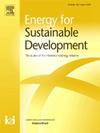基于系统动力学的太阳能光伏回收定性框架
IF 4.9
2区 工程技术
Q2 ENERGY & FUELS
引用次数: 0
摘要
随着能源需求的不断增加,太阳能光伏发电继续稳步增长。预计未来几十年将产生大量的太阳能光伏废弃物,但目前回收方法的经济可行性值得怀疑。虽然对回收方法进行了技术经济评估,但它们依赖于具有面向事件视角的线性回收模型。鉴于对清洁、可持续能源和循环经济的日益重视,对太阳能光伏回收的动态和因果关系进行全面分析是必不可少的。本研究提出了一个定性框架,结合关键的反馈循环,以更好地理解这些动态。因果循环图包括四个关键领域:能源需求、太阳能光伏增长、垃圾填埋场处理和回收。开发的模型确定了关键的杠杆和干预点。此外,通过分析各种强化和平衡循环的演变相互作用,本研究将印度太阳能光伏回收的演变分为三个不同的阶段:发展阶段(2025-2035),增长和优化阶段(2035-2050)和饱和阶段(2050-2075)。详细探讨了每个阶段的定义特征。本文章由计算机程序翻译,如有差异,请以英文原文为准。
System dynamics based qualitative framework for solar PV recycling
With the increasing demand for energy, solar PV continues to grow steadily. A massive volume of solar PV waste is expected in the coming decades, but the economic viability of the current recycling methods is questionable. While techno-economic assessments of recycling methods have been conducted, they rely on linear recycling models with an event-oriented perspective. Given the growing emphasis on clean, sustainable energy and the circular economy, a comprehensive analysis of the dynamics and cause-effect relationships shaping solar PV recycling is essential. This study presents a qualitative framework, incorporating critical feedback loops, to better understand these dynamics. The causal loop diagram includes four key domains: energy demand, solar PV growth, landfill disposal and recycling. The developed model identifies key leverage and intervention points. Additionally, by analysing the evolving interactions of various reinforcing and balancing loops, this study categorizes the evolution of solar PV recycling in India into three distinct phases: Development Phase (2025–2035), Growth and Optimization Phase (2035–2050), and Saturation Phase (2050–2075). The defining characteristics of each phase are explored in detail.
求助全文
通过发布文献求助,成功后即可免费获取论文全文。
去求助
来源期刊

Energy for Sustainable Development
ENERGY & FUELS-ENERGY & FUELS
CiteScore
8.10
自引率
9.10%
发文量
187
审稿时长
6-12 weeks
期刊介绍:
Published on behalf of the International Energy Initiative, Energy for Sustainable Development is the journal for decision makers, managers, consultants, policy makers, planners and researchers in both government and non-government organizations. It publishes original research and reviews about energy in developing countries, sustainable development, energy resources, technologies, policies and interactions.
 求助内容:
求助内容: 应助结果提醒方式:
应助结果提醒方式:


